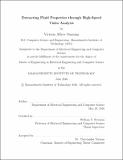Extracting fluid properties through high-speed video analysis
Author(s)
Gunning, Victoria Allyce
DownloadFull printable version (34.06Mb)
Other Contributors
Massachusetts Institute of Technology. Department of Electrical Engineering and Computer Science.
Advisor
William T. Freeman.
Terms of use
Metadata
Show full item recordAbstract
We explore a non-contact method to measure changes in fluid properties by analyzing refractive motion in high speed video. We present a method of extracting fluid properties by performing video motion analysis using an automated wavelength matching filter followed by fitting of the measurements to theoretical capillary-gravity wave dispersion equations. This method requires an understanding of how field of view, refraction, and parallax affect measurements. We tested the method by analyzing trends in the surface tension to density ratio for cooling water, and for water versus glycerol.
Description
Thesis: M. Eng., Massachusetts Institute of Technology, Department of Electrical Engineering and Computer Science, 2016. This electronic version was submitted by the student author. The certified thesis is available in the Institute Archives and Special Collections. Cataloged from student-submitted PDF version of thesis. Includes bibliographical references (pages 90-92).
Date issued
2016Department
Massachusetts Institute of Technology. Department of Electrical Engineering and Computer SciencePublisher
Massachusetts Institute of Technology
Keywords
Electrical Engineering and Computer Science.